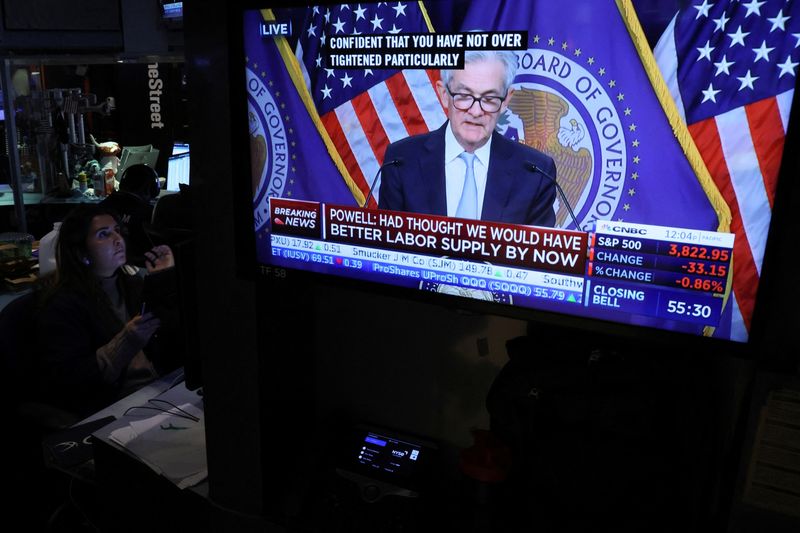By Jamie McGeever
ORLANDO, Fla. (Reuters) -What many people saw as an open goal for the Federal Reserve chair on Wednesday, it seems Jerome Powell saw as a potential own goal.
Nearly everyone expected him to use his eagerly awaited speech on the economic outlook and the labor market at the Brookings Institution think tank to push back on the significant easing of U.S. financial conditions in recent weeks.
Looser financial conditions - higher equities, lower dollar and bond yields, tighter credit spreads - make it harder for the Fed to succeed in its fight to cool the economy and get inflation back down towards target.
According to Goldman Sachs (NYSE:GS)'s financial conditions index (FCI), they have loosened over the last two months despite two 75-basis points rate hikes and promises from Fed officials - including Powell - of more tightening to come.
They have loosened significantly since Wall Street's cycle low in mid-October, and since the Fed's Nov. 2 policy meeting, leading most observers to think Powell would lean against markets on Wednesday, at least a bit.
But he refused to do so and investors were caught miles offside: the S&P 500 and Nasdaq both recorded their second biggest rises in over two years, adding 3.1% and 4.4%, respectively.
According to Morgan Stanley (NYSE:MS), the relief rally that engulfed risk assets produced the second-largest year-to-date easing in U.S. financial conditions, worth 30 basis points.
Goldman's FCI fell 21 bps to its lowest since Sept. 12, overwhelmingly led by the move in equities. By this measure, financial conditions now are easier than they were before the Fed's September and November rate hikes.
But in truth, what everyone assumed was the right thing for Powell to do on Wednesday - steer the market in the opposite direction - was probably not the right thing to do, and the Fed chief may have played it just right.
The lagged effects of this year's 425 bps of rate hikes have still to play out in the economy and the "pain" that Powell has previously warned is coming will be felt next year. Several measures of inflation suggest price pressures have peaked and are now steadily declining.
If all that is true, there may be less need to focus so heavily on financial conditions, and a more balanced monetary policy now is sensible.
"This is a tacit change in messaging. We can take this as some degree of evidence that the Fed is willing to accept the easing of financial conditions in the past several weeks," said Yung-Yu Ma, chief investment strategist at BMO Wealth Management.
BLACKOUT PERIOD
Economic and labor market data this week suggest the Fed's most aggressive rate-hiking cycle in four decades is starting to bite.
The Chicago purchasing managers index, a measure of factory activity in the Midwest, and the national ISM manufacturing index both slumped in November to levels typically associated with recession.
Meanwhile, private sector job growth across the country last month was far weaker than expected too.
If these indicators are useful guides to broader trends in the coming months, the Fed is right to be cautious. Powell said on Wednesday that the Fed has already been "pretty aggressive" and does not want to "crash the economy and clean up afterward."
To be clear, the Fed isn't completely turning its back on financial conditions. In his Q&A on Wednesday Powell repeated his view that a better barometer for policymakers is the extent to which real rates are positive.
By this measure, financial conditions have tightened considerably in recent months. Inflation-adjusted Treasury yields hit their highest in over a decade last month, rebounding sharply from historically negative levels earlier this year.
That said, the Fed chair knows the power of his words. He probably didn't anticipate such an outsized reaction, but he would have been well aware that investors were positioned for him to push back against the recent market rally and substantial easing of financial conditions.
Economists at Piper Sandler argue that Powell did not say anything new, and note that markets usually rally after his public communications. If the Fed decides it does want to push back against the market's interpretation of his latest comments, it might have to wait.
"The December FOMC blackout period starts on Saturday, so realistically the next opportunity for the Fed to correct market perception, again if needed, is the FOMC statement and press conference on Dec. 14," they wrote in a note on Thursday.
(The opinions expressed here are those of the author, a columnist for Reuters.)
Related columns:

- Shifting central bank goal posts
- Fed may harangue markets to prevent premature pivot
(By Jamie McGeever; Editing by Andrea Ricci)